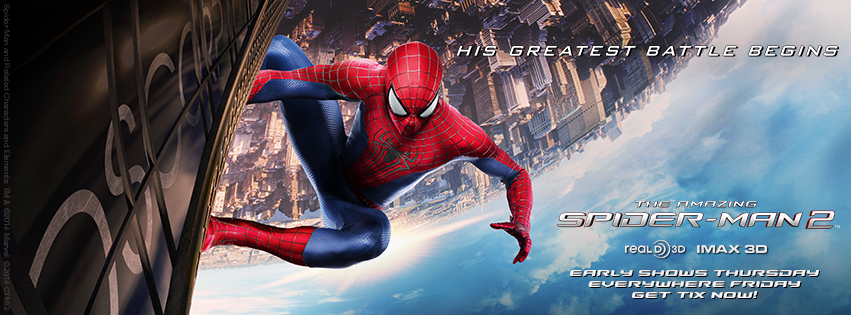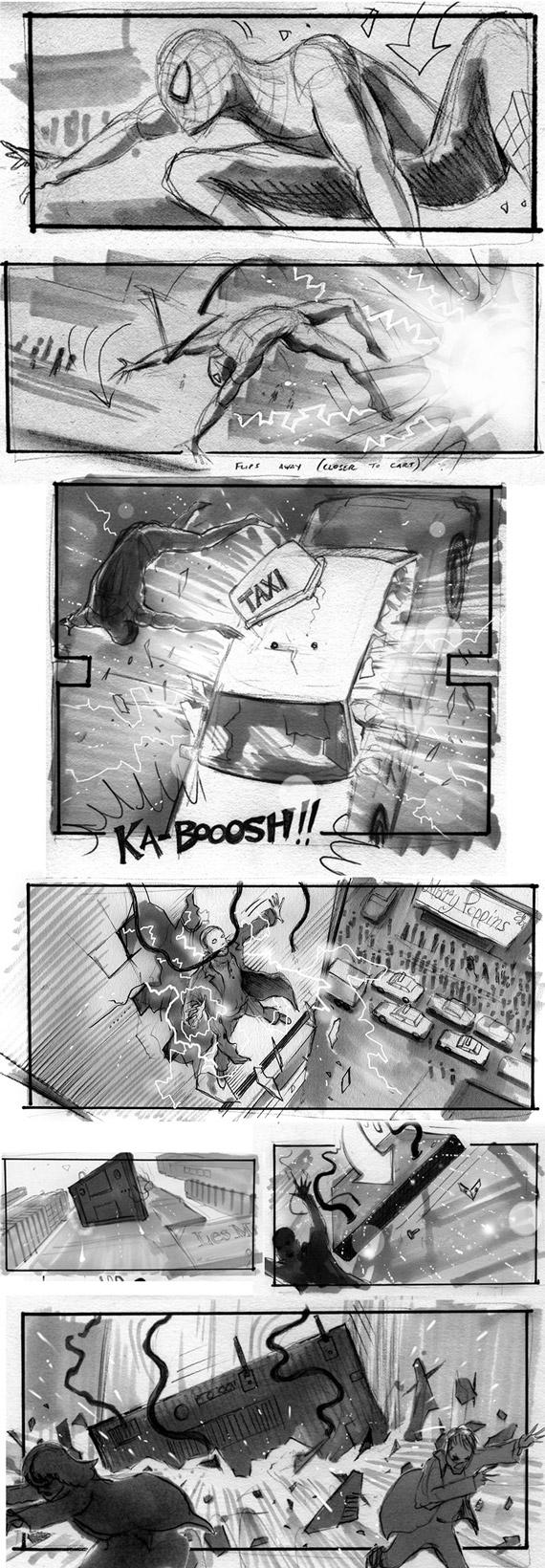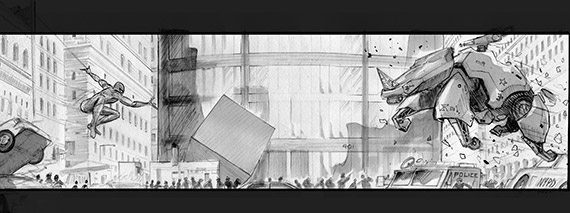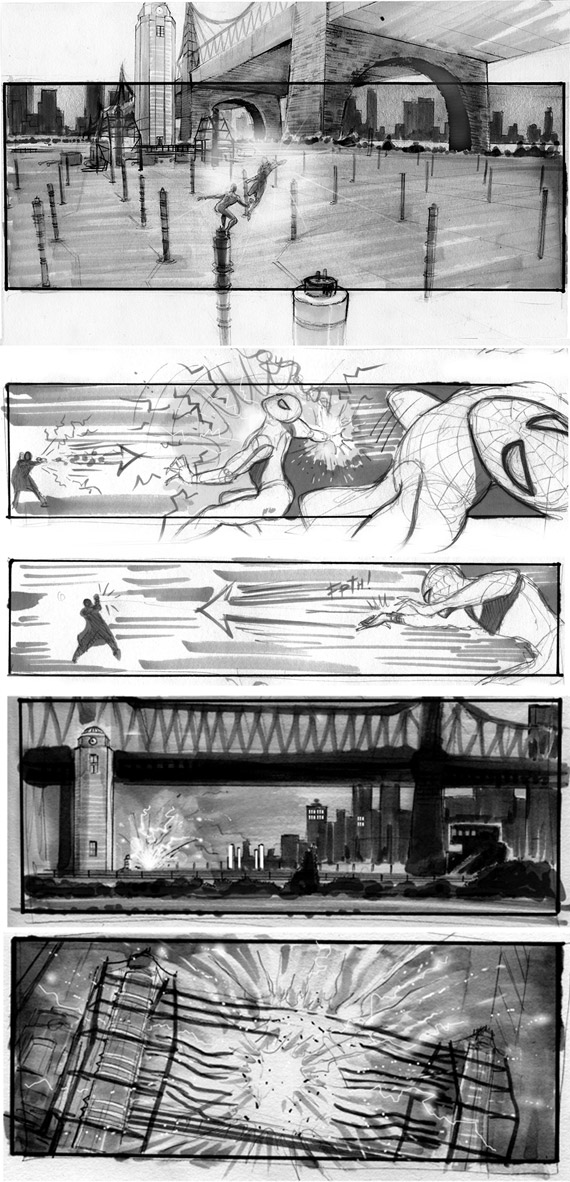 Our spidey senses are tingling! After weeks of anticipation, The Amazing Spider-Man 2, directed by Marc Webb, is FINALLY in theaters! With all of the super villains Peter Parker faces in this Marvel sequel, the action is non-stop. While you’re waiting to see the film, allow us to take you behind the scenes! We’ve interviewed our talented artist Jim Byrkit for his insights into the world of Spider-Man.
Our spidey senses are tingling! After weeks of anticipation, The Amazing Spider-Man 2, directed by Marc Webb, is FINALLY in theaters! With all of the super villains Peter Parker faces in this Marvel sequel, the action is non-stop. While you’re waiting to see the film, allow us to take you behind the scenes! We’ve interviewed our talented artist Jim Byrkit for his insights into the world of Spider-Man.

Give us an idea of what your process was like and working with Director Marc Webb?
Spider-Man is all about New York, and I knew it was crucial to be there in the middle of it and feel the city. So the very first day Marc and I walked all over Times Square, acting out the battle, talking about what buildings we would destroy, what kind of crazy action could happen there. Marc came prepared with a strong vision, and we had a blast crafting a rhythm of big and small beats, an ebb and flow of action.
Tell us more about your experience working in the city in the middle of time square with the director…
Marc is all about character, and so we had to constantly balance big action moments with human feeling. He was also surprisingly versed in all aspects of Spiderman, referencing the video game, the animated series, and a million other points of inspiration. Times Square became our playground and the first thing I did back in the production office was to build a cardboard model with toy cars so we could continue to hone the choreography. Marc also knows some great places to eat, drink, sing show tunes, or just about anything you could want in the city.

Who did you collaborate with most besides the director – production designers, set designers or visual effects artists? What was the process like?
I worked with the previs guys at 3rd Floor, and thankfully had amazing support from some awesome art department assistants that would gather reference, prepare presentations, and decorate my office with posters of kittens.
Are you given a full scene to draw at once, or just different sequences? Is the entire film boarded out or just certain parts of the film?
I’m almost always hired to tackle the absolute hardest parts of a big action script. The scenes that aren’t quite written, but everyone knows need some big concept. So usually I’m given one or two monster action scenes that require a creative take that both serves the story and blows it out somehow. It might be a humorous take, like for Jack Sparrow, or a splashy chase scene or a big destructive set piece like Times Square.
There is so much action in this film…how do you go about getting it right? What techniques do you use?
I draw as fast as possible, just to get the ideas down. I always try to shift my brain into the aesthetic of the director I’m working with. It’s key to feel their input, to merge with their mind, even when you’re generating a completely original sequence. This is why listening and vibing with the director is crucial. After I’ve spewed out my instinctive ideas on paper, I sometimes go back and hit some key frames, the shots that seem to encapsulate the sequence. There has to be an iconic sense to them, to know they are working. It’s always a back and forth between pure creative instinct and deliberate refinement of the frame. At the end of a great day, you can feel which frames are capturing the vision of the director. Sometimes I put them all up on a big board so you can see the entire sequence at once, it feels like an editing timeline. And you can feel the rhythm of it all, almost hear it when it’s working right.

There are so many well known actors in this film…do you have to draw likeness and if so…how do these frames differ from the others?
Usually I’m drawing so fast, I don’t worry about likenesses. But for a movie like Spiderman, it helps to remind the viewer of the boards that these are actual people. So maybe every fifth frame I will take some extra time and make Gwen look a little more like Emma. On Pirates, every now and then I would do a sketch that showed the performer’s real face and the actors and producers enjoyed that.
How is your process, do you start on paper then work digitally after, is it fully digital, or fully traditional?
I sketch pencil on paper with a quick gray pen for tone, then scan and adjust in photoshop. Sometimes adding little photoshop highlights or flares, or in this case, electric arcs.
What kind of preparation is needed to board a film like this?
For me, it’s about understanding where the director is coming from. 500 DAYS OF SUMMER was great and really gives a glimpse of Marc’s personality. His first Spider-Man movie showed how much emphasis he’s putting on character and his modern spin on everything. But I was already primed to jump in, just based on my love of the genre.
Did you face any challenges with this project that you can talk about? Any hurdles you had to overcome to get the job done?
Well I flew in just a couple days after Hurricane Sandy blew the town apart and the office situation was like a survivalist camp for a while. But that was more fun than anything. The only tricky part was that I missed my ten-month old son so much I had to keep flying back to see him.

How long have you been working in the business as a storyboard artist?
I began storyboarding when I got out of school in the mid 1990’s. As I started directing commercials and television, once in a while I would continue to design frames and sequences for certain directors that I enjoyed working with.
We know you also direct and write projects? What do you have up your sleeve right now, anything you can share?
Yes, I’m promoting my first feature COHERENCE, which couldn’t be less storyboarded. A mostly improvised mind-bender that Oscilloscope is releasing in June.
How does having directing experience assist you as a storyboard artist when you collaborate with your director on a project?
I try to be the storyboard artist that I wish I had as a director. Which means I try to be as available as possible, as flexible as possible, and as mindful as possible. It’s about merging with the director, and providing a whole other brain that can be tackling problems and suggesting solutions before they materialize.
What advice would you give a young storyboard artist who would like to have a career in film like you have?
Do what you love and push yourself farther than you ever thought possible. Approach every early opportunity like a ninja, like an invisible expert assassin who is there to make the director’s problems go away. Be like Leon in THE PROFESSIONAL. If there are no opportunities, create the opportunities. Reach out to every possible contact you have. Seek out interesting people and stay in touch with them.

